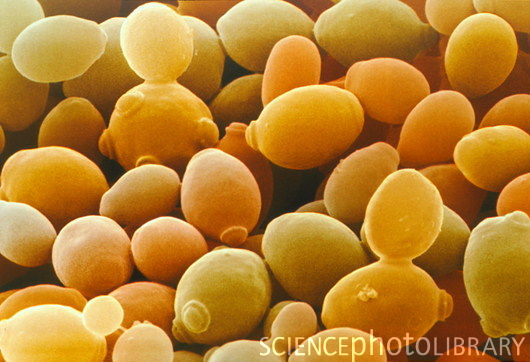据英国《新科学家》杂志网站9月15日(北京时间)报道,美国生物学家人工合成出两个染色体片断并将其放入一个活酵母菌体内,酵母菌仍能正常存活,未出现明显异常。科学家们计划在接下来的5年内用人造基因组取代酵母菌的所有基因组,让其进化出新菌株。

约翰霍普金斯大学医学院的生物学家杰夫•博伊科领导的科研团队不仅从头设计并制造出了新的基因组,也找到了“拼凑”这些基因组以制造出新染色体的方法。此前曾有研究人员人工合成过一种细菌的基因组,但细菌属于原核生物,而酵母属于更高级的真核生物。本次研究是世界上首次成功合成真核生物的部分基因组,标志人工合成生物基因组的研究又迈出了重要步伐。
酵母菌有16个染色体,所有染色体都已被排序。博伊科团队首先用已知的染色体序列做起点,在计算机上设计出新序列,随后剥去了所有不为蛋白质编码的不必要基因,接着在所有不必要基因的终端添加了标记物,标记物可在不杀死酵母菌的情况下被修改或删除,而一种名为Cre的酶会攻击这些标记并在标记点之间交换基因。最终,博伊科团队在实验室制造出了两个新的染色体片断,并将其插入一个活酵母菌体内,用其替代9号染色体和6号染色体的一部分。
博伊科打算继续使用这种基因交换技术改变酵母菌的其他染色体,因为该方法只针对非必需基因,并不会干扰其内部结构。在很大程度上,科学家们能制造出健康的酵母菌。这种基因交换技术能测试不同的基因排列对酵母菌的影响,比如用来探索基因组被删去多少后生物仍能存活,或是探索基因组被打乱、改变到什么程度才会产生新物种。“取出一个酵母菌基因并将其插入基因组中的某处,你有可能得到一个健康的酵母菌,或许我们会发现基因组结构内还有些隐藏的规则。”博伊科说。
除了用于制造面包和啤酒,普通的酵母菌也已被用来制造疫苗。科学家们也制造出了能用于合成生物燃料的转基因酵母菌。通过这种新的人工合成基因技术,科学家能够得到不同属性的酵母,比如生长率、对药物敏感程度、温度敏感性都不同的酵母,用于不同目的的研究。
生物探索推荐英文文章阅读:
Synthetic yeast will evolve on command
Yeast is going digital. Biologists have built two artificial chromosome arms and put them to work in a living yeast. They plan to replace the entire yeast genome over the next five years and then evolve new strains to order.
"Nothing like this has ever been done before," says Jef Boeke of the Johns Hopkins University School of Medicine in Baltimore, Maryland, who is leading the research. As well as designing and building the new genome from scratch, his team has come up with a way to systematically scramble it to produce new strains.
The artificial yeast are similar to Craig Venter's synthetic cells, announced last year. Venter replaced the entire genome of a bacterium with a synthetic genome – but the task is far harder in yeast, because it is a more complex organism and has a bigger genome.
Yeast has 16 chromosomes, all of which have been sequenced. Boeke started small, replacing the right arm of chromosome 9 and part of the left arm of chromosome 6. He began by designing the new sequences on a computer, using the known sequence as his starting point. He stripped from this virtual DNA all the meaningless "junk" DNA, which does not code for proteins. Then he added markers called loxPsym at the ends of all non-essential genes – those that could be changed or deleted without killing the yeast. In the real world, these markers can be attacked by an enzyme called Cre, which swaps genes between the marker sites. Finally, he created these new sequences in the lab using the chemical building blocks of DNA, and inserted them into a living yeast in place of its natural chromosome arms.
Shuffling genes
"This is another remarkable example of how synthetic biology can be used to rewrite chromosome sequences at a sizeable scale," says Daniel Gibson of the J. Craig Venter Institute in Rockville, Maryland. He says it could help us understand the rules governing genome structure.
For instance, the reshuffling technique can test how different arrangements of genes affect the yeast. Boeke has already done this by shuffling the genes on the artificial chromosomes using the Cre enzyme.
"You can take a yeast gene and insert it somewhere else in the genome, and you tend to get a healthy yeast," Boeke says. That suggests a reshuffle wouldn't matter, but different yeasts consistently use the same order. "Maybe there are hidden rules of genome structure that we can distil," Boeke says.
Make your own yeast
Boeke now intends to repeat this re-engineering process with the other chromosomes in yeast. Once the entire genome is laced with loxPsym sites, Boeke plans to use Cre to make wholesale changes. Because the method targets only non-essential genes, and does not interfere with their internal structure, it should mostly produce healthy yeast.







